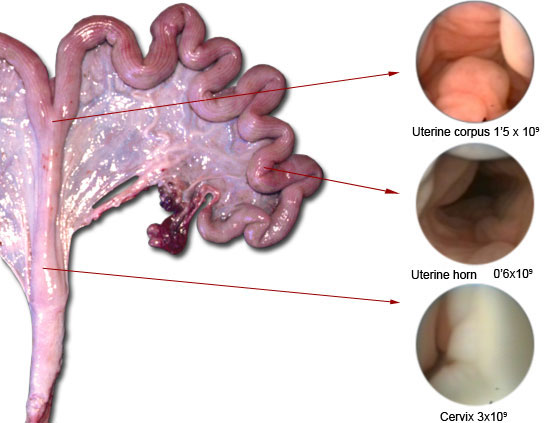
Figure 1 - Representation of the different insemination systems in genital organs obtained from the slaughterhouse; a) Anatomical disposition of the genital organ; b) Standard artificial insemination: depositing semen in the cervical duct; c) Post-cervical insemination: depositing the semen in the uterine corpus; d) Deep intrauterine insemination: depositing the semen in the depth of the uterine horn.

Figure 2 - Number of spermatozoa required for insemination based on the point of deposit.
When fresh or refrigerated semen is used in countryside conditions, the number of spermatozoa and the volume of the dose using PCI can diminish to1’5x109/50ml with results similar to those obtained with the standard IA, which is why, being simultaneous, this technology is changing the routines of a great number of farms, since it is a sure and simple method to apply. However, a reduction greater than that of the aforementioned variables (1x109 spermatozoa/30ml) could imply a significant decline in the number of piglets born per sow, per farrowing. Indeed, although Watson and Behan (2002) concluded that PCI allows for the reduction of spermatozoa to 1x109 without affecting fertility or prolificacy, other scientists have concluded that, under said conditions, the total number or piglets born is significantly lower than that obtained with the IA standard (Rozebom and cols,. 2004; Roberts and Bilkei, 2005). Even more so, when the number of spermatozoa used in post cervical insemination is reduced to 0’5x109, the birth rate can decline up to 10 points in comparison with the traditional IA group, and the difference in the litter size between both IA systems increases ostensibly (Rozeboom and cols., 2004).
Another real alternative to reduce the number of spermatozoa per dose is using the DUI method. Using this technology, the sperm dose can be deposited in the depth of a uterine horn quickly and easily, although the cost of this system is high. Several studies comparing DUI with the standard IA indicated that DUI allows for a reduction of 20 times less inseminated spermatozoa and dose volume (0’15x109 spermatozoa/5ml) without affecting the birth rate percentages nor the litter size when the ovulation of the sows to be inseminated was hormonally induced (Martinez and cols., 2002). However, when DUI was used with the same conditions but on weaned sows with spontaneous ovulation, the litter size was smaller (1-2 less piglets) in comparison with the results obtained using the standard IA (Day and cols., 2003; Martinez and cols., 2006). It has been shown that this decreased prolificacy is due to an increase in unilateral fertilizations (Martinez and cols., 2006) and that this anomaly can be surpassed by increasing the number of spermatozoa and the volume of the dose to 0’6x109 spermatozoa and 20 ml, respectively.
These proceedings could have an elevated economic impact on the fresh-semen IA swine industry, since it will allow for the reduction of boars headed for IA. Therefore, the selection of boars can be intensified, using only the most elite, in order to assure high quality descendants (homogeneity). Logically, the importance of such a reduction is parallel to the degree of the decrease of the number of spermatozoa per dose obtained with each one of the IA systems (Table 1). These proceedings can also be of great benefit in cases of sanitary eventualities where the number of insemination doses is found to be diminished. Plus, the decrease in space, feed, management and housing of the boars, and the decrease in time needed for obtaining, evaluating, and preparation of the seminal doses are other aspects to consider. As far as inconveniences of these insemination techniques goes, it is worth mentioning the need for a certain amount of personnel training, careful management of the animals, and the exclusive use of genetically superior boars that will not transmit undesirable defects to their descendants.
Table 1.- Seminal patterns with different artificial insemination proceedings.
| Traditional insemination (3x109 spza/100 mL) |
Post Cervical insemination (1’5x109 spza/50 mL) |
Deep intrauterine insemination (0’6x109 spza/20 mL) |
|
| Ejaculation frequency | 2 times/week | 2 times/week | 2 times/week |
| Dose per ejaculation | 20 |
40 |
100 |
| Dose per year |
2.000 |
4.000 |
10.000 |
| Proportion of boars | 10 | 5 | 2 |




